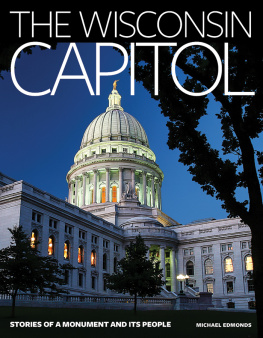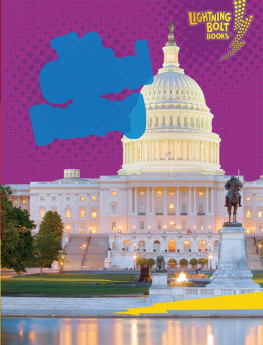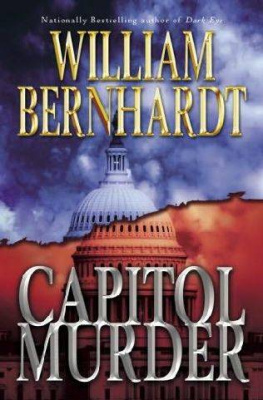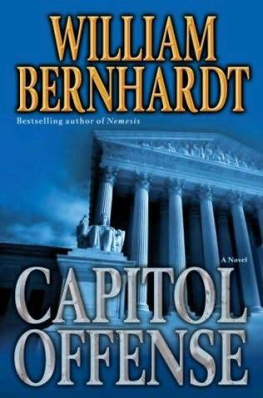A GREAT MANY ARCHIVES AND RESEARCH INSTITUTIONS ARE AVAILABLE for anyone seeking to explore the rich and intriguing history of the Capitol Building, Congress, and Capitol Hill. The author drew on the knowledge of many organizations, including the Library of Congress, Cultural Tourism DC, the Architect of the Capitol, the National Portrait Gallery, the National Archives, the archives of the US House of Representatives and US Senate, Congressional Cemetery, Oak Hill Cemetery, and the White House Historical Association. Among the particularly useful publications and blogs were American Heritage, Smithsonian, the archives of the National Intelligencer, the Streets of Washington, the Washington Post, the Washington Examiner, and WETAs Boundary Stones, as well as JSTOR and Find a Grave. The collections of the Washington Historical Society deserve special praise. As do leading authors on relevant subjects, such as Anthony Pitch, Mary Kay Ricks, Tom Lewis, Candace Millard, Robert V. Remini, P. J. ORourke, Garrett Peck, Peter Schweizer, and Joanne Freeman, among many others.
The book is based heavily on research the author performed for stories he tells in his capital region travel events: The Lafayette Square Tours of Scandal, Assassination, and Spies, as featured on TripAdvisor, Meetup, Airbnb Experiences, Eventbrite, Travel Curious, the Mayflower Hotel, and Atlas Obscura.
The author would like to heartily thank all lovers of history, culture, architecture, and art, who provide the inspiration and support for his books, articles, and travel excursions.
And also the thoughtful and thorough work of editor Ellen Urban and publishing manager Eugene Brissie, so easy to work with.
And a vigorous nod to the authors hard-laboring, book-loving parents. The Lost History of the Capitol was completed in very busywork weeks in the midst of the worldwide viral outbreak that originated in Wuhan, China. But to quote an oft-used family phrase: Hard work never hurt anyone.
New Jersey Avenue, south of the Capitol Building and north of the Longworth House Office Building
IN NOVEMBER 1791, THE FEDERAL COMMISSIONERS OVERSEEING THE construction of Americas new capital city were shocked. And stunned most of all was Daniel Carroll of Rock Creek.
THE DISAPPEARING MANSE
The officials were visiting the southern fringe of Jenkins Hill, which the citys planner, Pierre LEnfant, had selected as the site of the future Capitol Building. They went along a rude path near what would become New Jersey Avenue. They approached the home of Carrolls nephew, Daniel Carroll of Duddington.
Or what was left of it. Daniel of Duddington was the largest landowner in the area, and owner of the land that would become Capitol Hill. He had been building his new house there: not on the land slated for the public buildings, but on his own property.
To their astonishment, the commissioners confirmed what LEnfants two deputies, Isaac Roberdeau and Benjamin Ellicott, had done. Roberdeau was the son of a provisioner of George Washingtons army during the American Revolution. Ellicott was the brother of Andrew Ellicott, charged with surveying the boundaries of the new city.
Roberdeau and Ellicott had directed a team of men to take apart the unfinished house. They had ripped off the roof and stripped away its stone foundations.
THE BEST MAN FOR THE JOB
The commissioners could hardly believe what they saw. Less than a year before, when President George Washington had selected LEnfant as the citys designer, the Frenchman had seemed an excellent choice. A master of the arts and of science, hed moved to America to help it win its independence. He served with the Marquis de Lafayette as a military engineer, rising to the rank of major. A skilled artist, he sketched portraits of General Washington.
After Washington was sworn in as president, LEnfant grandly redesigned what became Federal Hall in New York City, the federal governments first capital. The Hall was the first meeting place of the US Senate and House of Representatives, and home to the offices of the president.
However, problems cropped up of the kind that would plague LEnfant in his later endeavors. His designs for the Senate and House chambers were showy and expensive. Some saw them as suited more to a House of Lords than a democratic republic.
In 1790, the first Congress passed the Resident Act, that compromise of Washingtons Treasury secretary, Alexander Hamilton, and secretary of state, Thomas Jefferson, to place the permanent capital in a new city. They had struck their deal in the room where it happened, a dining hall in the temporary capital of New York. They chose the border land of Maryland and Virginia, in between the Northern and Southern states, and in the backyard of the Virginian Founding Fathers.
In March 1791, at Suters Tavern in the bustling seaport of Georgetown, LEnfant met with Washington, Ellicott, and the landowners and merchants of the region. They began to thrash out an approach for building the capital.
But from the start, LEnfants ambitious aims differed from some in the government. The Washington Administration was under a constitutional mandate to establish a functioning capital city by early 1800. Jefferson, who was Washingtons point man for the project, suggested LEnfant plot out a small government town just east of Georgetown.
Yet like Jefferson and Washington on other matters, LEnfant figured that, if you dream, you should dream big. The Frenchman proposed a grand, if grandiose, scheme. His creation would stretch from Rock Creek, northeast of Georgetown, through an expanse of woodlands, ridges, and marsh. Its terminus was a full five miles away, at the Potomacs Eastern Branch, as the Anacostia River was then known.
He proposed a humongous presidential mansion, measuring about 230 yards across, three to four times more spacious than the future White House, which itself would be the largest residence in the nation. He took Jeffersons notion of a wide boulevard open to the people and sketched out what would become the National Mall. And he proposed putting the houses of Congress atop the steep, forested Jenkins Hill, even though its cliffs and woods made construction difficult. LEnfant, thinking such a promontory made for a majestic view, notably termed it a pedestal awaiting a monument.
Power Brokers
In going about his work, it was in LEnfants interest, if not his nature, to cultivate good relations with the politically powerful city commissioners.
They were: David Stuart, the stepfather of Martha Washingtons son from her first marriage, and thus a relative of LEnfants boss President Washington; Thomas Johnson, the first governor of Maryland, and in time a US Supreme Court justice; and, quite importantly, as it turned out, Daniel Carroll of Rock Creek, of Marylands leading family, perhaps best known for Charles Carroll of Carrolton, the only Catholic signer of the Declaration of Independence as well as John Carroll, the founder of Georgetown College, later Georgetown University, established in 1789, the same year Washington became president. Daniel Carroll of Rock Creek had been a major player at the Constitutional Convention that had established the new Congress and presidency.
There were so many important Carrolls that, to differentiate themselves, they called themselves after their localities, such as Rock Creek, Carrollton, and Duddington.
This was the very clan that LEnfant irked with his building deconstruction!
BITING THE HAND THAT FEEDS
Even before the Carroll homes dismantlement, LEnfant courted trouble. His very ambitious plans, not surprisingly, fell behind schedule. The commissioners had to coax him into hiring 150 workmen, including many slaves, to start building the Presidents House, or Presidents Palace, as it was originally called. LEnfant and the commissioners squabbled over whom was the ultimate authority for the citys construction. Further, Congress was stingy with appropriations.











